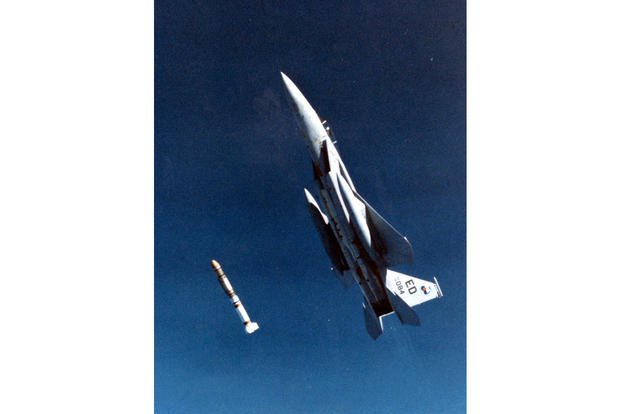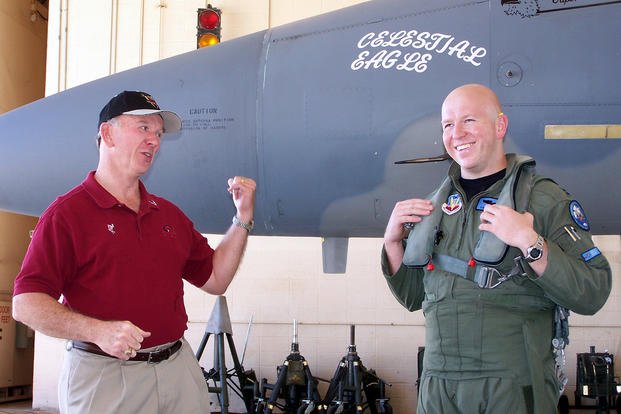The national security of the United States is currently imperiled by a new threat from Russia, according to the White House: a “troubling” emerging, anti-satellite weapon that, while ostensibly incapable of “physical destruction” on the ground, could severely disrupt U.S. military and civilian operations in outer space. Some U.S. government officials suspect the system may be nuclear, a prospect that raises concerns that the Russian government could not only disable strategic satellites in orbit, but, in turn, deal a major blow to the U.S. economy by degrading both government and civilian space-based operations. The threat is apparently so dire that lawmakers in Congress are sounding alarm bells to the public.
Luckily, the U.S. military has a relatively simple countermeasure in place to deal with space-based weapons: just send up a fighter jet to blow the damn thing out of the sky. After all, the Air Force had done it before — once.

A F-15 fighter jet piloted by then-Maj. Wilbert ‘Doug’ Pearson Jr. flies an ASM-135 anti-satellite missile on Sept. 13, 1985. (Paul E. Reynolds/U.S. Air Force photo)
In 1985, as the Cold War was winding down, the U.S. military found itself with a relatively new problem. The Soviet Union had developed a “robust” ability to launch small satellites into orbit that could keep track of U.S. Navy warships at sea, a capability that diminished the Pentagon’s ability to suddenly project power at any shore in the world without significant risk of detection, according to Maj. Gen. Wilbert “Doug” Pearson Jr. (ret.), the one and only Air Force pilot to ever shoot down a satellite in orbit above the planet.
The U.S. military had been pursuing anti-satellite weapons since the dawn of the space race with the launch of the Soviet satellite Sputnik 1 in 1957, especially as fears of Russian space nukes grew at the height of the Cold War. According to Smithsonian magazine, previous efforts to develop anti-satellite weapons included air-launched ballistic missiles as well as “adapted versions” of the ground-launched, anti-ballistic missiles system, among others. None of those efforts proved viable solutions, although a fast-moving aircraft appeared the most likely platform to deliver a kill vehicle to an adversary’s satellite.
“Earlier programs identified how absolutely difficult it was to hit a satellite with another object, because things in space, in order to be in orbit around the Earth, have to move at very high velocities, and hitting something at very high velocities is very difficult,” Pearson told Task & Purpose of his miraculous space kill in a 2020 interview.
Advertisement
In response to the Soviet Union’s rapid development of “co-orbital” anti-satellite weapons in the late 1970s — weapons “designed to reach orbit, sync up with their targets and detonate, sending shrapnel out to destroy enemy satellites,” per Smithsonian — the Carter administration launched a weapons program that would lead to the development of the ASM-135 missile, the very system that Pearson would use to eventually take out a satellite in orbit. The underlying concept of the ASM-135 was simple: An aircraft would launch a two-stage missile at altitude that would then release an autonomous “Miniature Homing Vehicle” that would then impact an enemy satellite, breaking it into pieces at velocities reaching thousands of miles per hour.
By the early 1980s, Pearson was commander of the F-15 Anti-Satellite Combined Test Force out of Edwards Air Force Base in California. When the time came to test the ASM-135, the F-15 was the logical choice for a delivery vehicle. At the time, the twin-engine fighter jet “was the real racehorse of the fighter community,” as Pearson put it in his 2020 interview. “It was big enough and powerful enough that it could carry a fairly large missile on the centerline. So it was the perfect choice. And it had good navigation capabilities, very reliable, and it could operate from many bases along the East or West coast.”
After five successful test launches of the ASM-135 missile from an F-15, Pearson’s team decided that the time had come to test the system on a real-world satellite target. The team chose the Solwind P78-1 satellite, a solar observation platform that had been orbiting the planet at an altitude of around 325 miles since it was launched from Vandenberg Air Force Base in 1979.
The day of the launch came down to Sept. 13, 1985. After rendezvousing with a refueling tanker about 200 miles from Vandenberg AFB, Pearson finally moved into position at an altitude of 30,000 feet to launch the ASM-135 at the Solwind satellite, which was moving at a speed of around 17,500 mph some 300 miles above Pearson’s aircraft. According to Smithsonian, Pearson “lit the afterburners, accelerated the airplane to Mach 1.3, and pulled into a 60-degree climb” before hitting his aircraft’s “pickle button” and launching the missile toward its target.
The ASM-135 missile quickly accelerated to 13,000 feet per second, streaking off into the distance. Because he couldn’t get visual confirmation of impact with the Solwind satellite, Pearson keyed his microphone to talk to the Air Force team on the ground at Vandenberg AFB, but his friend SCott on the ground “couldn’t get a word out because all the screaming and yelling at the control room totally overrode him,” as Pearson recalled in his 2020 interview.
“Thirty-five years ago, hitting a bullet with a bullet seemed impossible to many people,” Pearson told Smithsonian. “The F-15 ASAT program clearly demonstrated one high-speed object — faster than a speeding bullet — could be guided to a precise impact on another, even faster object.”

Retired Maj. Gen. Doug Pearson (left) and his son, Capt. Todd Pearson, joke with one another on Sept. 13, 2007, prior to Capt. Pearson taking off on the Celestial Eagle remembrance flight at Homestead Air Reserve Base, Fla. (Erik Hogmeyer/U.S. Air Force photo)
Despite his successful shootdown of a satellite in orbit, Pearson’s glory was short-lived: The ASM-135 program only conducted two additional test flights before lawmakers in Congress slashed the effort’s funding the following year, according to Smithsonian. Pearson would go on to retire in 2005 as the commander of the Air Force Flight Test Center at Edwards AFB.
And while the U.S. has since developed other methods to disable satellites — the Navy destroyer USS Lake Erie used a Standard Missile-3 to kill a malfunctioning National Reconnaissance Office satellite in 2008 — nobody else has matched Pearson’s distinct honor as a “space ace” since that fateful day in 1985.
“I don’t know exactly what happened, but we demonstrated we could do it,” said Pearson of the discontinued program. “And we made it look relatively easy. It wasn’t, but it looked that way.”





